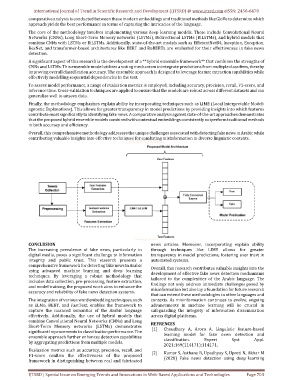Page 713 - Emerging Trends and Innovations in Web-Based Applications and Technologies
P. 713
International Journal of Trend in Scientific Research and Development (IJTSRD) @ www.ijtsrd.com eISSN: 2456-6470
comparative analysis is conducted between these modern embeddings and traditional methods like GloVe to determine which
approach yields the best performance in terms of capturing the intricacies of the language.
The core of the methodology involves implementing various deep learning models. These include Convolutional Neural
Networks (CNNs), Long Short-Term Memory networks (LSTMs), Bidirectional LSTMs (BiLSTMs), and hybrid models that
combine CNNs with LSTMs or BiLSTMs. Additionally, state-of-the-art models such as EfficientNetB4, Inception, Exception,
ResNet, and transformer-based architectures like BERT and RoBERTa are evaluated for their effectiveness in fake news
detection.
A significant aspect of this research is the development of a **hybrid ensemble framework** that combines the strengths of
CNNs and LSTMs. This ensemble model utilizes a voting mechanism to integrate predictions from multiple classifiers, thereby
improving overall classification accuracy. The ensemble approach is designed to leverage feature extraction capabilities while
effectively modelling sequential dependencies in the text.
To assess model performance, a range of evaluation metrics is employed, including accuracy, precision, recall, F1-score, and
inference time. Cross-validation techniques are applied to ensure that the models are robust across different datasets and can
generalize well to unseen data.
Finally, the methodology emphasizes explain ability by incorporating techniques such as LIME (Local Interpretable Model-
agnostic Explanations). This allows for greater transparency in model predictions by providing insights into which features
contribute most significantly to identifying fake news. A comparative analysis against state-of-the-art approaches demonstrates
that the proposed hybrid ensemble models combined with contextual embeddings consistently outperform traditional methods
in both accuracy and efficiency.
Overall, this comprehensive methodology addresses the unique challenges associated with detecting fake news in Arabic while
contributing valuable insights into effective techniques for combating misinformation in diverse linguistic contexts.
CONCLUSION news articles. Moreover, incorporating explain ability
The increasing prevalence of fake news, particularly in through techniques like LIME allows for greater
digital media, poses a significant challenge to information transparency in model predictions, fostering user trust in
integrity and public trust. This research presents a automated systems.
comprehensive framework for detecting fake news in Arabic
Overall, this research contributes valuable insights into the
using advanced machine learning and deep learning
development of effective fake news detection mechanisms
techniques. By leveraging a robust methodology that
tailored to the complexities of the Arabic language. The
includes data collection, pre-processing, feature extraction,
findings not only address immediate challenges posed by
and model training, the proposed work aims to enhance the
misinformation but also lay a foundation for future research
accuracy and reliability of fake news detection systems.
that can extend these methodologies to other languages and
The integration of various word embedding techniques, such contexts. As misinformation continues to evolve, ongoing
as ELMo, BERT, and FastText, enables the framework to advancements in machine learning will be crucial in
capture the nuanced semantics of the Arabic language safeguarding the integrity of information dissemination
effectively. Additionally, the use of hybrid models that across digital platforms.
combine Convolutional Neural Networks (CNNs) and Long
REFRENCES
Short-Term Memory networks (LSTMs) demonstrates [1]
significant improvements in classification performance. The Choudhary A, Arora A. Linguistic feature-based
learning model for fake news detection and
ensemble approach further enhances detection capabilities
classification. Expert Syst Appl.
by aggregating predictions from multiple models.
2021;169(114171):114171.
Evaluation metrics such as accuracy, precision, recall, and [2] Kumar S, Asthana R, Upadhyay S, Upreti N, Akbar M
F1-score confirm the effectiveness of the proposed
framework in distinguishing between real and fabricated (2020) Fake news detection using deep learning
IJTSRD | Special Issue on Emerging Trends and Innovations in Web-Based Applications and Technologies Page 703

